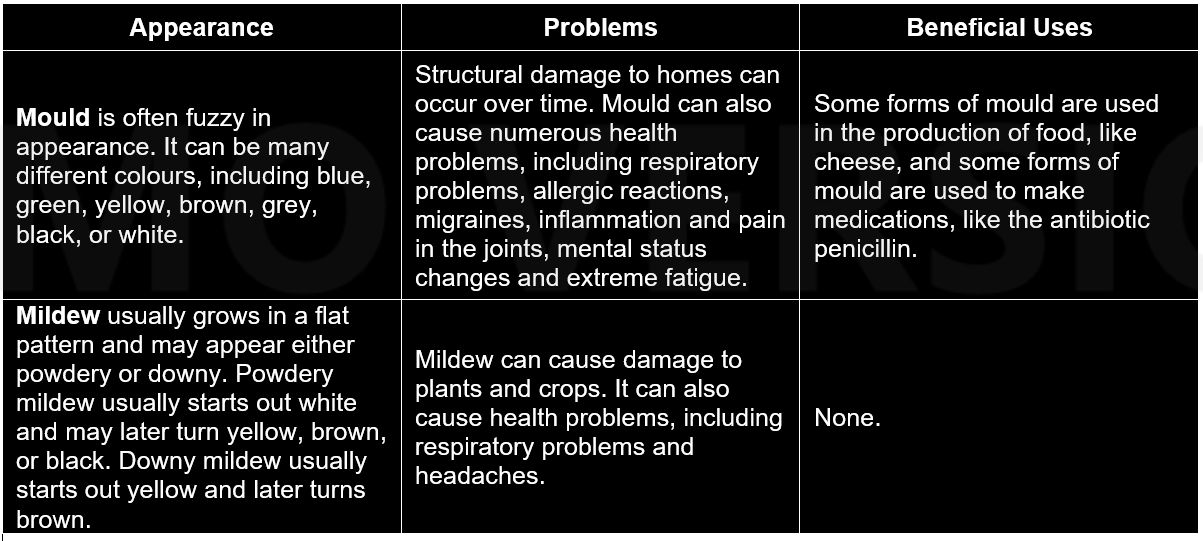If you’ve noticed the appearance of a dark patch forming in the bathroom, around a window or on a wall, don’t ignore it. Mould is an indicators that you may have a larger underlying damp problem within your home.
In the short term, mould might appear to simply be a harmless eyesore but, if left untreated, it can damage the structural integrity of your home. More importantly, it can be harmful to people, particularly young children, the elderly, and those with respiratory problems (such as asthma), skin conditions, or a compromised immune system.
What is mould?
Mould is a fungus that grows in a humid environment. Like any fungus, mould produces airborne spores that can easily spread to other damp areas.

Why has my home got mould?
Finding out what causes the mould is an essential step towards getting rid of it. It might be that your property is in a naturally high humidity area, such as near the coast or under trees. Periods of inclement weather can exacerbate the problem, wherever you live, and the general increase in humidity can encourage mould growth.
Mould will only start to grow when a surface has been wet for at least 24 hours so, if you see it, it’s possible your home has a problem.
Condensation is one of the biggest culprits, which is why many homes have mould in the bathroom, but it can appear on any surface that is not cleaned or washed regularly, including roof timbers. If condensation isn’t the issue, mould could be caused by pointing problems in brickwork, leaky guttering or something more serious, like rising damp.
If you’re unsure, ask an independent surveyor to carry out some simple checks to analyse the seriousness of the problem and its cause.
How can I get rid of mould?
Specialist antimicrobial mould sprays are available or, if the problem isn’t too serious, you can mix up your own solution of one part bleach to four parts water. Use the solution to remove the mould by gently scrubbing the area with a damp cloth until it’s removed. Once finished, dry the area well with a clean cloth.
When you clean away mould, make sure the area is well ventilated and that you wear rubber gloves and a mask and safety goggles. That may sound excessive, but breathing in the fumes of mould cleaner or mould spores can seriously harm your health.
As well as cleaning the area, you will need to identify what’s caused it, so you can stop it from happening again.
Does bleach kill mould?
Bleach will clean off surface mould and can remove some or all of the discoloration that mould leaves on the wall, but it may only be a temporary solution. Bleach doesn’t kill off the spores that cause mould to grow and eventually it will grow back.
Baking soda and/or vinegar effectively kill mould spores better than bleach and can be used separately or combined.
For a simple DIY solution, mix a third of vinegar to as much water as you want to use. Alternatively, create a thick paste from one part vinegar and two parts baking powder, which can be thinned down with water, if needed. The paste should be applied to the affected areas and left to dry before removing with a stiff brush and wipe clean with a damp cloth. To finish up, spray a mist coat of a vinegar and water mix to help kill off any straggling spores.
How can I prevent mould and mildew from coming back?
Remember that mould grows from spores and doesn’t appear without the right conditions. Cleaning your home regularly will reduce the likelihood of dormant spores growing. Organic materials, such as carpet, cardboard, fabrics and wood, provide surfaces on which mould spores feed. Cleaning and washing these surfaces regularly will help get prevent the problem.
- Ventilate rooms by opening windows.
- Close the door when using the bathroom or kitchen.
- Use an external extractor fan when showering or cooking.
- Don’t dry clothes on radiators, and open a window when using the tumble dryer.
- Invest in a dehumidifier if you live in a humid area or if you cannot easily reduce the humidity in the home.
Condensation can be reduced by improving air circulation in the room. Open curtains during the day to allow air to circulate around cooler window areas. Dry any areas that appear to be damp as soon as you notice.
If your property is suffering from rising damp, you may need to add a damp proof course. This creates a barrier which prevents water from being absorbed from the ground.
Surveyors come across mould issues almost every week. If you’re concerned about a mould formation, damp patch or any other symptom of dampness don’t hesitate to speak to your local Property Surveying professional. They can guide you through the sensible steps to take and give advice tailored to your particular issue.


